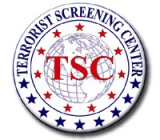|
|

FACT
SHEET
The U.S. Terrorist Screening Center (TSC), charged with
maintaining the U.S. government’s consolidated terrorist
watchlist, established a formal watchlist redress process
in January 2005. The goal of watchlist redress is to provide
for timely and fair review of individuals’ watch
list-related complaints and to identify and correct any
data errors, including errors in the terrorist watchlist
itself.
Working closely with federal inter-agency partners over
the course of many months, a Memorandum of Understanding
on Terrorist Watchlist Redress Procedures (MOU) was agreed
upon and signed September 2007. The MOU standardizes preexisting
inter-agency watchlist redress procedures allowing individuals
an opportunity to receive a timely, fair, and accurate
review of their case.
Federal Inter-agency MOU Partners
- With support from the White House Privacy and Civil
Liberties Oversight Board, as well as senior-level
federal inter-agency officials, the signatories agreed
upon and co-signed the Watchlist Redress MOU:
- Department of Justice
- Federal Bureau of Investigation
- U.S. Terrorist
Screening Center
- Department of State
- Department of Defense
- Department of the Treasury
- Central Intelligence
Agency
- Department of Homeland Security
- Office of the Director
of National Intelligence
- National Counterterrorism
Center
MOU Inter-agency Commitments
- The formal signing of the redress MOU ensures
that federal inter-agency partners have an official
document that outlines the screening and nominating
agencies ’ mutual
understanding of their obligations, responsibilities,
and accountability as part of the redress process.
Following are the key commitments:
- Designate a Responsible Official . Ensures
accountability by requiring each party to designate
a senior official responsible for the party’s
full participation in the redress process and
overall compliance with the redress MOU.
- Information Sharing. Requires
inter-agency cooperation and information sharing
to coordinate and resolve redress complaints
appropriately.
- Data Protection . Requires
parties to secure personal information received by
and exchanged between agencies during the redress process.
- Data Correction. Obligates parties
to update and correct their records when erroneous
information is identified.
- Resources. Requires that each party
provide appropriate staff and other resources to ensure
the redress process functions in a timely and efficient
manner.
- Privacy Act Compliance. Each
party is responsible for its own compliance with
the Privacy Act of 1974, 5 U.S.C. § 552a,
in the collection, maintenance, use, and dissemination
of personally identifiable information.
How the Redress Process Operates
- Individuals are encouraged to file a complaint about
an adverse screening experience with the agency that
conducted the screening. The agency will then determine
if the experience may be related to the terrorist watchlist.
- Up to 96 percent of the redress referrals received
by TSC come from the U.S. Department of Homeland Security
(DHS), home to a number of screening agencies such as
U.S. Customs and Border Protection, U.S. Citizenship
and Immigration Services, and the Transportation Security
Administration.
- U.S. Department of Homeland Security recently launched
DHS TRIP or DHS Traveler Redress Inquiry Program as the
central gateway for redress complaints for all DHS Agencies.
DHS TRIP is a web based program that can be found through
the DHS website by visiting [ www.dhs.gov/trip ].
- If the agency determines that an individual complaint
appears to be watchlist-related, it is referred to
TSC’s
independent Redress Unit. The TSC does not directly accept
redress complaints from the public because the screening
agency is in the best position to determine if the individual’s
difficulty was related to the watchlist. Rather,
TSC provides the necessary research and review allowing
the screening agency to respond to the complaint
directly.
- TSC’s Redress Unit, an independent and impartial
office, follows written procedures to receive,
track, and research watchlist-related complaints,
to consult with agencies that nominate individuals
to the watchlist, and to correct the watchlist or
other data that may cause an individual unwarranted
hardship or difficulty during a screening process.
- Since 2005, TSC’s independent Redress Unit
has successfully resolved over 90 percent of the
redress complaints referred by federal inter-agency
partners.
Inter-agency Cooperation
- In the fall of 2005, the TSC completed a first
draft of the MOU intending that it would formally
document the screening and nominating agencies’ mutual
understanding of their obligations and responsibilities
arising out of the watchlist redress process.
- Throughout 2006, with the support of the White House
Privacy and Civil Liberties Oversight Board and chief
privacy officers from the Departments of Justice and
Homeland Security, and the Office of the Director for
National Intelligence, a multi-agency working group comprised
of representatives from the participating agencies met
to negotiate the final terms of the MOU.
- In December 2006, the working group completed a
final draft of the MOU, and in September 2007 the MOU
was fully signed by the heads of all participating
agencies.
Read
the press release
The U.S. Terrorist Screening Center (TSC), established
December 2003 by Homeland Security Presidential Directive-6,
serves as the U.S. government’s consolidation point
for known and suspected terrorist watchlist information,
both foreign and domestic. The consolidated watchlist
contains thousands of records that are updated daily
and shared with our federal, state, local, territorial,
tribal law enforcement, and intelligence community members
as well as international partners to ensure that individuals
with links to terrorism are appropriately screened. The
TSC, administered by the Federal Bureau of Investigation
and supported by federal departments and agencies that
include the departments of Justice, Homeland Security,
and State, the Office of the Director of National Intelligence,
and the National Counterterrorism Center, ensures that
information provided to and consolidated by TSC is thorough,
current, and accurate.
| Press Releases | FBI
Home Page |
|
|


